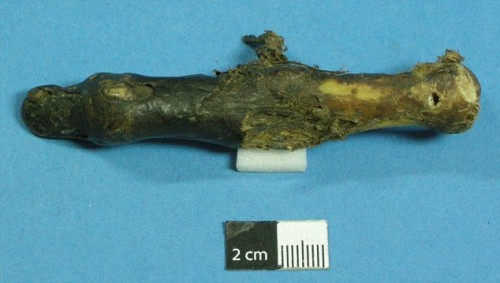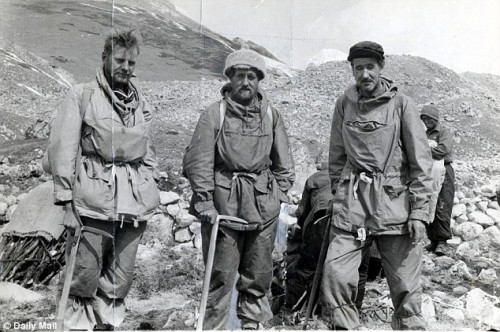
Well Peoples, I’m on vacation but wanted to help out anyway. Unfortunately, I have limited connectivity in this backwater town I’m visiting. So, don’t be too hard on Javier as he is handling the whole load whilst I’m away.
I was lucky enough to get to a house today that has a broadband connection. So, I decided to throw up a story while I had a chance.
Most are aware of the now famous Yeti finger spirited from Monks in a Himalayan monastery.
It is said that the Pangboche Buddhist monastery is so remote that only the ceremonial horns used by Monks will guide you in during the frequent blinding snow storms.
For those who aren’t privy to the story of the Yeti finger, Here’s an episode of Unsolved Mysteries to fill you in (For those in a hurry, find results of DNA below):
Yes it was the famous Tom Slick who organized the procurement of the Yeti finger via his associate and explorer Peter Byrne. It was Byrne who convinced Monks to allow him to replace the Yeti finger with a human one. Later Byrne would smuggle the finger out of the country.
Long story short, the finger ended up at the Hunterian Museum at the Royal College of Surgeons in London where it sat for many years. It was recently rediscovered and a sliver was sent to the Royal Zoological Society of Scotland for DNA analysis where it was (to the dismay of all) found to be, without a doubt, human.
All that trouble only to discover the famous finger was not the amazing discovery it was built up to be.
Here’s more on the story from the Daily Mail:
The Yeti, a severed finger spirited from Nepal, and a famous film star. DNA tests will finally solve a truly bizarre mystery
Set high in a remote Himalayan mountain range stands the Pangboche Buddhist monastery.
During heavy snowstorms, it can be found only by travellers who listen for the monks’ ceremonial horns.
The walls are lined with traditional Nepalese paintings depicting the treacherous tracks to the monastery.
And among them are pictures of the legendary ape-like creature we refer to as the Yeti.
This might seem fanciful until you learn that, for many years, a shriveled hand (about the size of an adult human’s, with long, fat fingers and curling nails) was also on display in the monastery — and revered by the monks, who believed it protected them from bad luck.
I would know nothing about this story were it not for the fact that while walking around a collection of human and primate skeletons at the Royal College of Surgeons in London three years ago, I came across a withered finger which had only recently been found in the vaults of the College’s Hunterian Museum. It was labelled ‘a Yeti finger from Pangboche hand’.
What was the story behind this finger, I wondered, and how did it end up in London? Where was the rest of the ‘Pangboche hand’? And what truth was there behind the label’s claim that this finger belonged to the Yeti of ancient legend?The myth has it that the Yeti, or Abominable Snowman, is a vast creature which inhabits the Himalayan regions of Nepal and Tibet, where tales about Yetis have been passed down through generations.
Fossil remains found there from the Pleistocene age (2,500,000 to 11,700 years ago) reveal skeletons of a creature called the Gigantopithecus, or great ape, which became extinct 300,000 years ago.
These towering primates reached about 10ft in height and weighed half a ton.
It is possible they lived alongside our human ancestors in what are now China, India and Vietnam. Yet the scientific community generally regards this species simply as a large, extinct ape — and the Yeti as nothing more than a legend.
Tales of the Meh-te, or ‘man bear’ as Yetis are known in Nepal, gained popular currency in the West only in the 1830s when the Journal of the Asiatic Society of Bengal published British orientalist B. H. Hodgson’s account of a tall, two-legged creature covered with dark hair that he claimed to have seen while trekking in Nepal.
Reports became more frequent in the 20th century as Westerners began making attempts to scale the Himalayas, and reported seeing strange footprints or odd creatures. In 1925, a photographer with the Royal Geographical Society reported seeing a creature near the world’s largest glacier, the Zemu, in India.
N. A. Tombazi wrote that ‘unquestionably, the figure in outline was exactly like a human being, walking upright and stopping occasionally to pull at some dwarf rhododendron bushes’.
He says the creature’s prints were ‘similar in shape to those of a man, but six to seven inches long by four inches wide’.
The Daily Mail sponsored an expedition in 1954 to investigate recent Yeti sightings reported in the paper’s pages. During the trek, mountaineer John Angelo Jackson tracked and photographed many footprints, some of which were large and could not be identified as belonging to any known animal.
The Mail subsequently ran an article which described how expedition teams obtained black and dark brown hair specimens from what was said to be a Yeti scalp in the same Pangboche monastery.
In 1953, Sir Edmund Hillary and Sherpa Tenzing Norgay reported seeing large footprints while climbing Everest, although Hillary remained a confirmed Yeti sceptic.
In 1974, reports of a Yeti attack on the wife of a Sherpa reached Britain. Lap Kadoma was supposedly thrown into a river by a large creature which approached her from behind. When she regained consciousness, she found a number of dead yaks lying nearby.
Her injuries were not like those inflicted by snow leopards or bears, which tear the carcasses of their prey apart. Instead, the yaks bore teeth marks and their flesh had been eaten.
Then, in 1957, Tom Slick, a wealthy American oilman, funded a series of expeditions to investigate Yetis.
He became obsessed after hearing about them on business trips to India.
It was a year later, during one of the expeditions funded by Slick, that the Irish-American explorer Peter Byrne heard two Sherpas mention the word ‘Meh-te’.
When quizzed, they told him about the ancient Yeti hand preserved in the Pangboche Monastery. Days of trekking through treacherous passes with the ever-constant threat of avalanches followed as Byrne made his way to the magnificent monastery.
He remembers walking the halls by candlelight and being led to the room which contained the Pangboche hand. ‘It was covered with crusted black, broken skin,’ Byrne says.
He sent a runner over the border to India with a message for Slick about his find. It took three days for the return telegram to arrive with instructions from Slick to obtain the hand and to bring it to London.
But the monks refused to let Byrne take their revered object, explaining that if they let it go, it would bring down a curse on the monastery. Slick was determined, however. He arranged to meet Byrne in London, where they were joined by world-renowned primatologist Professor William Osman Hill.
The venue was the restaurant at Regent’s Park Zoo, where the professor was employed dissecting and embalming dead animals.During the meal, Osman Hill told Byrne that he had to get hold of at least one finger from the hand because he wanted it to be scientifically analysed.
The professor — who had links to the Royal College of Surgeons — then reached under the table and brought out a brown paper bag.
He tipped a human hand onto the table, and suggested Byrne replace the finger with a human one.
Slick could only exclaim: ‘I take it that’s not dessert?’
Byrne returned to the monastery, and although the monks were reluctant, they eventually agreed to part with the finger for £100 — only if Byrne could find a way of disguising the missing digit.
The mountaineer wired the human finger on to the relic, before painting it with iodine to make it look the same colour as the rest of the hand. He now faced a perilous journey home.
In the previous year, the Nepalese government — bizarrely — had brought in a law making it illegal for foreigners to kill a Yeti.
Thus, Byrne took a risk by trekking on foot over the border into India with the digit. The challenge was to smuggle it back to London by plane without the authorities finding it and asking awkward questions.
Slick, as ever, had a solution. An old hunting buddy of his was in India and might be able to assist Byrne. The friend turned out to be none other than the movie star Jimmy Stewart.
Slick knew that Stewart was on holiday in Calcutta and thought he might be sufficiently intrigued by the Yeti legend to help out. So a meeting was arranged in the Grand Hotel in Calcutta with Byrne, Mr Stewart and his wife Gloria.
His instincts were right. The Stewarts were happy to go along with it. In order to dodge customs, Gloria hid the finger in her lingerie case and they flew out of India with no trouble.
Back in London, the finger was handed over to Professor Osman Hill for examination. Chillingly, his tests — which involved comparisons with human hands — concluded that it was not human.
But there the story goes cold. No more was heard of it for many years, although it is known that Osman Hill eventually bequeathed it to the Hunterian Museum, where it languished until work on this collection brought the finger to light once more.
No one knows why, after all the effort to obtain the finger and bring it back to London, it was just handed over to the museum to be neglected and forgotten.
My discovery of the finger at the Royal College of Surgeons came quite by chance during a visit, and it kindled my interest in the mystery of this strange artefact.
Having learned the briefest outline of its history, I was able to track down the now 85-year-old Peter Byrne, who was astonished.
I took him to see it at the museum. After examining the object, he verified it as the same finger he had taken. The Royal College of Surgeons then granted my request for a tiny sliver of it to be analysed in DNA tests.
These were administered by the Royal Zoological Society of Scotland and the results will be revealed in a special BBC Natural History documentary on Radio 4 today.
Now, there is a growing movement to have the finger returned to its rightful owners.
Mike Allsop, a New Zealand mountaineer, is championing the campaign to help the monastery get it back.
He told the monks about the whereabouts of the missing finger on a recent visit, and they have asked for its safe return. The Royal College of Surgeons says it would oblige if asked.
Meanwhile, the legend of the Yeti remains as strong as ever.
There were 15 reported sightings in Siberia last year alone. And Kemerovo State University in Russia is even setting up a research institute to look into Yeti reports and sightings.
Man’s appetite for the possibility of an undiscovered species of ape will never be sated. It seems unlikely there will ever come a day when the Yeti legend will be fully resolved. But perhaps, like all the best mysteries, that’s the way it should be.
For the full result of the DNA analysis, listen to Yeti Finger on BBC Radio 4 today at 11am.
Source: The Daily Mail
No waiting here! See link to BBC radio broadcast below for results:
BBC Radio Broadcast-Yeti DNA Results
1 comment





